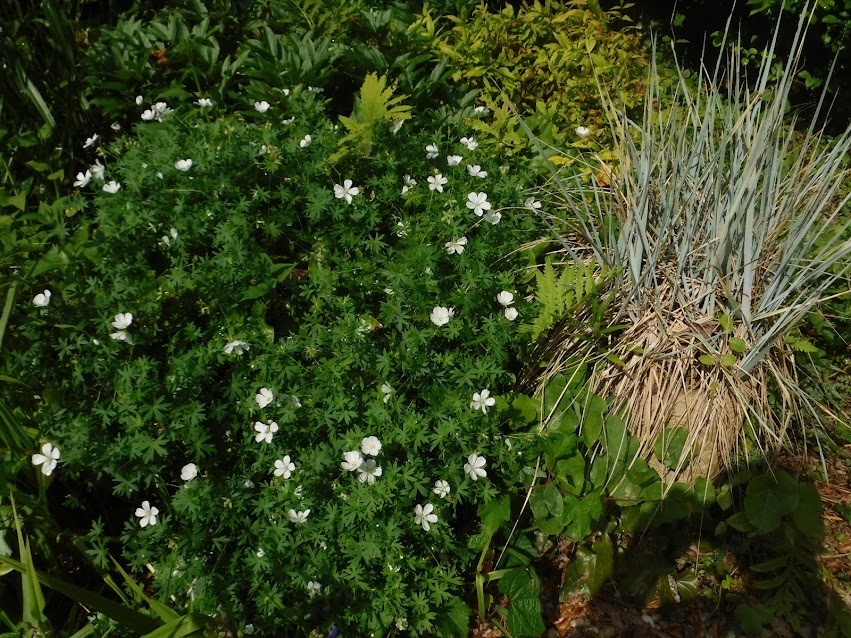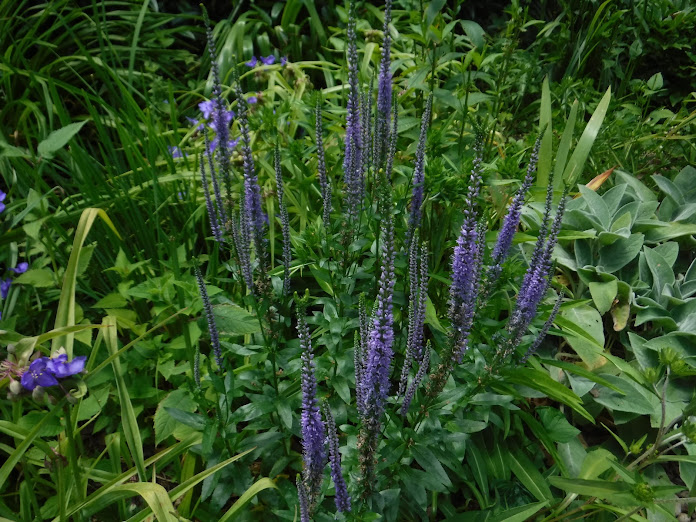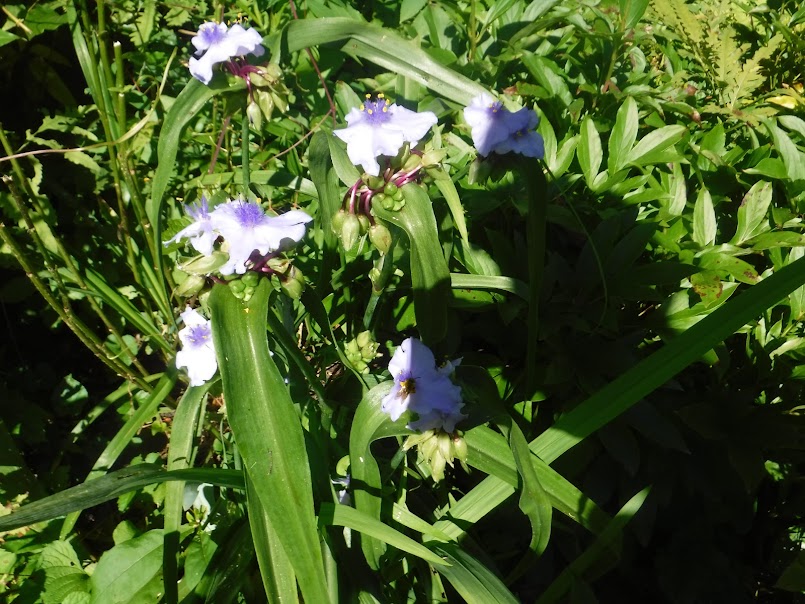Oenothera tertragona is a dependable Evening Primrose, and, fortunately, it doesn't wait until evening to bloom. In fact, it is too vigorous, and once bloomed, if time permits, the number of plants will be cut by 75%. I am sure it will multiply again to a respectable display.
The blue toned clone of the Southern native Zenobia pulverulenta, the dusty Zenobia. If other species of Zenobia are in the World, I don't know of any.
Always pleased by the forms of Tradescantia virginica that show up. A lifetime ago, I bought a variety of distinct and named colors. They have all, since, blended and are replaced. And the species color of blue-violet is the most often seen.
This vigorous Geranium has stayed in place and does not grow as tall as some other sorts. Good for the front of the little perennial bed. G. sanguinieum 'Alba'. An excellent Geranium, but I avoided the normal color.
Always around, but not often noticed, these Boxturtles can be identified by eye color and if the bottom shell is concave or curving slightly out. Males have red eyes and concave shells.
The Hydrangea vine, 'Moonlight' has a strange glow to the leaves. The Deer don't seem to bother it. It grows on the fence that hides a mess of trash cans, ladders and assorted other stuff.
This late blooming Azalea was chosen not for the tomato soup color as much as that it a ground hugging dwarf sort. Named 'Flame Creeper'.
Below is a sort of Hypericum called H. kalmianum. A vigorous taller ground cover, evergreen in Winter. At the very corner where the walk to the front porch starts.

Itea virginica, another underused native, does not annoy me, as it does others, with worm shaped flower clusters that turn some off. This selection is said to turn dark reddish, before losing leaves for Winter. Named I.v. 'Henry's Garnet'. Another blooms at the path towards the tool shed. That is dwarfer, and named 'Little Henry'.
This is a form of the locally common Arrow Wood, Wild Raisin, Viburnum dentata. I am hoping it is the select form, that bears clear blue berries, called 'Blue Muffin', rather than the common dark berries.
Lysmachia minutissima was rescued, but some remain at the edge of the little pond, which is a fine spot for the plant. Taller plants will overwhelm it.

Fothergilla 'Blue Shadow' is in two places on the property simply because I like silvery or blue foliaged plants. As I have said often, the seller said Fall color is not special, but I find it gets nice soft orange shades. The flowers are typical and appreciated.
This is a chosen form of our native Viburnum nudum, developed by Winterthur gardens in Delaware. I think they named it 'Winterthur' and the common name for the shrub is 'Possumhaw'. The berries turn reddish, then dark blue, and, in Fall, the shiney leaves turn mahogany, before falling,

The classic form of Hydrangea quercifolia, our native Oak Leaved Hydrangea, released by Rutgers University, here in NJ. 'Snow Queen'. Nice mahogany and orange foliage in Fall and distinctive Winter bark.
Two other more dwarf sorts of the Oak Leaved Hydrangea edge the exit drive. I don't think I saved the names. Very attractive to the deer, somehow.
With many magnificent forms of Iris ensata, the Japanese species, in cultivation, I have only this smaller bloomed, simple white. If I see another, locally, I might buy it.
Really do appreciate this classic purple-blue Veronica crowded in among the other perennials where vehicles park. Strange how the color carries so poorly in photos my camera takes.
Just another of the great variety of color among Tradescantia virginica, among those same perennials. Severely controlled by me, but I will always have a selection. Even some doubles, never having purchased even one of those. Commonly called Spiderwort, but I am unsure of the derivation of that name, as it could come from the stringy sap that comes if a stem is broken, or because of the fine filaments in the center of each flower. To my entertainment, the woman that sold us this land called this flower 'Noonsleeps' as they close up by then, except if the weather is shady or wet.
Another Honeysuckle. Lonicera sericea, I think. Among the tangle of vines on the fence that hides the above ground pool side from view from where we park.
The third form of Lysmachia, here. Lysmachia punctata. In the main little perennial bed. I thought the species had a black ring in the bloom and don't know why mine don't. Grown from seed, years ago, and perfectly dependable, while not overly invasive, like Spidewort.
My named, and very hardy sort of the evergreen Southern Magnolia, Magnolia grandiflora 'Bracken's Brown Beauty'. Named for the notable rust colored indumentum, or hairy covering on the underside of each leaf.




























Hope all is well with you and yours.
ReplyDeleteLove that geranium. I am looking for it now but so far I can't find it.
ReplyDeleteI planted some veronica last summer. The color was outstanding. For some reason this year it seems kind of faded. I have that same magnolia but it has never bloomed though it is growing nicely.
ReplyDelete